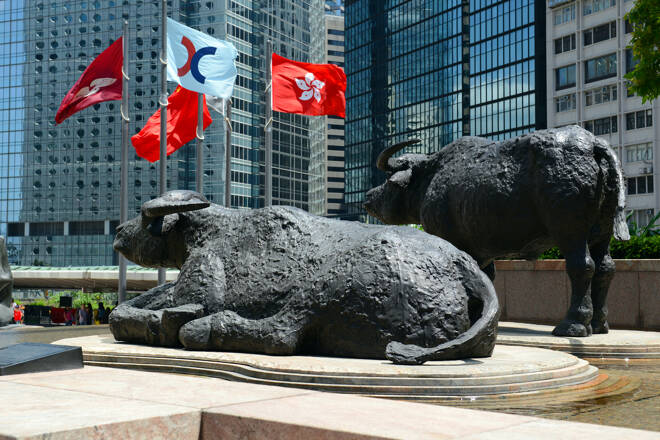Advertisement
Advertisement
Hang Seng Index Drops on China Growth Concerns; Tech and Real Estate Lead Losses
By:
Key Points:
- Hang Seng Index falls as weak China data and concerns about the latest stimulus fueling growth concerns.
- Nikkei 225 rallies 1.58%, driven by yen weakness and strong gains in tech stocks like SoftBank.
- ASX 200 hits an all-time high at 8,331.7, with mining and banking stocks leading the way.
US Equities Reach Historic Highs on Columbus Day
On Monday, October 14, the US Equity Markets extended their gains from Friday, climbing to historic highs. Because of the Columbus Day holiday, there was no US economic data or bond market trading to test demand for riskier assets.
Despite the holiday, investors remained hopeful about Fed rate cuts in November and December, supporting optimism for a soft US economic landing.
On Monday, the Nasdaq Composite Index and the S&P 500 saw gains of 0.87% and 0.77%, respectively, while the Dow advanced by 0.47%.
China Trade Data Highlights Declining Demand, Calls for More Stimulus
On Monday, trade data from China signaled a sharp decline in demand. Exports increased by a slower 2.4% year-on-year in September, compared to a rise of 8.7% in August. Imports were also lackluster, aligning with the weekend’s inflation figures that indicated intensifying deflationary pressures.
The disappointing data followed China’s Ministry of Finance (MoF) press conference on Saturday. Reaction to the fresh fiscal policy measures resonated, with the markets waiting for measures to boost household spending.
Negative sentiment toward China’s fiscal stimulus measures overshadowed the risk-on sentiment from the overnight US session.
Expert Views on China’s Stimulus Measures
Natixis Asia Economist Alicia Garcia Herrero commented on the wave of stimulus measures from China, stating,
“On the one hand, it is clear that stimulus will come. On the other hand, it is not clear how big it would be and certainly whether it will affect households directly.”
Notably, deflationary pressures have accelerated because of a slump in private consumption.
Hang Seng Index and Mainland China Equities Fall on Growth Concerns
Turning to the Asian equity markets, the Hang Seng Index declined by 1.27% on Tuesday morning, extending its losses from Monday. Uncertainty about the effectiveness of Beijing’s stimulus measures to reboot the Chinese economy affected demand for Hong Kong-listed stocks.
HK-listed real estate and tech stocks contributed to the losses. The Hang Seng Mainland Properties Index (HMPI) declined by 1.35%, while the Hang Seng Tech Index (HSTECH) dropped by 1.01%.
Key tech movers included Baidu (9888) and Alibaba (9988), which slid by 2.90% and 2.66%, respectively. Real estate stocks saw heavier losses, with Shimao Group Holdings Ltd. (813) and Agile Group Holdings Ltd. (3383) seeing declines of 5.63% and 3.8%, respectively.
Mainland China’s equity markets also struggled as economic concerns affected investor sentiment. The CSI 300 fell by 0.44%, while the Shanghai Composite declined by 0.51%.
Nikkei Rallies on Yen Weakness and Tech Sector Gains
In contrast, the Nikkei Index was up 1.58% on Tuesday morning. The USD/JPY pair gained 0.45% on Monday, closing at 149.745, with the move toward 150 boosting demand for export-linked stocks. Overnight US tech stock gains also contributed to the positive morning session.
Tokyo Electron (8035) and Softbank Group Corp. (9984) led the rally, surging by 5.07% and 6.85%, respectively.
ASX 200 Strikes All-Time High
On Tuesday, the ASX 200 Index gained 0.89% in the morning session, hitting an all-time high of 8,331.7. Banking and mining stocks led the rally.
Mining giants BHP Ltd. (BHP) and Rio Tinto Ltd. (RIO) advanced by 0.86% and 1.36%, respectively. Tuesday’s 0.20% gain in iron ore spot prices further fueled demand for mining stocks. Hopes that China’s fiscal stimulus measures will support its real estate sector drove iron ore prices higher.
Additionally, the Commonwealth Bank of Australia (CBA) and the National Australia Bank (NAB) were up 1.92% and 1.75%, respectively. Expectations of multiple Q4 2024 Fed rate cuts drove demand for high-yielding Aussie bank stocks.
Looking Ahead
Investors should remain vigilant, with stimulus chatter from Beijing and Bank of Japan commentary requiring consideration. On Tuesday, Japan’s industrial production figures will also draw interest. A downward revision to a prelim 3.3% slide in production could weaken the Japanese Yen further, potentially influencing the Nikkei Index.
About the Author
Bob Masonauthor
With over 28 years of experience in the financial industry, Bob has worked with various global rating agencies and multinational banks. Currently he is covering currencies, commodities, alternative asset classes and global equities, focusing mostly on European and Asian markets.
Did you find this article useful?
Latest news and analysis
Advertisement
